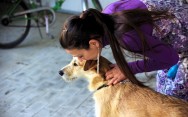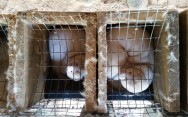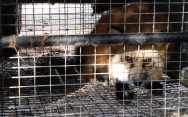Blog Archives
Home -
Posts tagged "animal rights"
As Morocco prepares to host the 2030 FIFA World Cup, there have been reports of mass culling of
stray dogs in an effort to “clean the streets” before the tournament. A collective of ten animal rights
organizations, including Eurogroup For Animals and Four Paws, has written to FIFA, urging the
organization to take a stand against this horrific slaughter. Morocco had previously committed to a
humane dog population management strategy through a ‘Trap, Neuter, Vaccinate, Release’ (TNVR)
program, yet reports suggest that authorities are instead resorting to killing stray dogs in violation of
their own policies and with wanton cruelty.
The Moroccan government has justified these actions under the pretext of controlling rabies, a fatal
disease transmitted through bites. This contradicts the scientific evidence and the government’s
prior commitment to sustainable measures such as TVNR, which are proven to be more effective as
well as being humane. The open letter from animal rights groups calls on FIFA to use its influence to
hold Morocco accountable for its commitments and ensure that dog population management is
ethical, upholds previous commitments and does not sacrifice animal lives.
The situation raises urgent ethical questions about humanity’s treatment of animals that do not
serve our self-interested purposes. Stray dogs, often dismissed as nuisances, are living beings
deserving of dignity and compassion. Their existence in our cities is not their fault but rather a
consequence of human neglect and mismanagement. To kill them for the sake of a sporting event
reflects a disturbing willingness to sacrifice lives for aesthetics and convenience. As a global
institution with immense influence, FIFA has a responsibility to take a stand against cruelty and
support humane solutions.
With five years to go before the tournament, Morocco has the opportunity to stick to ethical and
sustainable measures to care for their stray dog population rather than wantonly killing them. FIFA
must use its platform to pressure the government from preventing a catastrophic mass killing,
ensuring that the World Cup is not tainted by the horrific suffering of animals that are discarded as if
their lives had no meaning. The world is watching, and now is the time to demand a humane
approach that values animal lives as equally.
The Moroccan dog “genocide” must be stopped. Sign the petition to tell FIFA that they must us their
pressure to stop these catastrophic mass killings: https://actionnetwork.org/petitions/the-
international-animal-coalition-is-calling-on-fifa-to-demand-morocco-stop-killing-dogs-for-the-world-
cup
For more on our educational and advocacy programs on behalf of animals, please visit our website:
https://www.freedom4animals.com/
|
Tags: Animal Freedom,
Animal Genocide,
Animal Massacre,
animal rights,
FIFA,
Kevin Boileau,
Morocco,
Nazarita Goldhammer,
Rabies,
Stray Dogs,
TNVR,
Transhumanism,
World Cup
On December 2, 2025, Mexico made a historic leap forward for animal rights by amending its
Constitution to include protections for nonhuman animals. This reform is the first of its kind in the
nation. While many countries have animal protection laws, few have elevated the protection of
animals to constitutional status, and even fewer have extended this to cover all species, including
farmed animals. Mexico’s new constitutional changes mark a groundbreaking shift towards treating
animals as beings deserving of legal recognition and rights, regardless of their species.
In most countries, animal welfare laws are selective, often prioritizing companion animals over those
in agricultural industries. In the United States, for example, farmed animals are often excluded from
protections that apply to pets or wildlife. Mexico’s reforms aim to change that by ensuring all
animals, from farmed animals to those kept as pets, are entitled to legal protection. This
approach could set an example for other nations, particularly in Latin America, where animal rights
movements are gaining momentum. However, with Mexico being one of the world’s top producers
of meat and animal products, it is highly probably that economic interests will hinder the
implementation of these reforms. Agricultural lobbyists could easily push back against these laws to try to
protect profits.
One particularly important aspect of the reforms that could have a positive impact on the future is
education. The changes require the inclusion of animal welfare education in Mexican schools. In the
best-case scenario this could influence a new generation that values and understands animal rights.
It could be the first step in changing cultural attitudes towards animals on a larger scale. While the
specific details of this educational shift have yet to be defined, the hope is that it will lead to a
transformation in how Mexican society views and treats animals in the future.
The constitutional amendment represents a step forward in recognizing animals as sentient beings
with rights, but the true test will be in the details. It is unlikely that Mexico will go far enough in
creating strong, enforceable laws that truly afford equal protection to animals. On the other hand,
this victory sends a message about the direction society is capable of going if social imagination can
conceive of animals as equal beings to humans. There are many self-interested forces at work trying
to convince humans that it is too difficult to value animals in parity to ourselves, that there are too
many problems or steps to be taken, and true equality for animals is not possible. Legislation at a
constitutional level proves that changes can be far-reaching and can affect all animals.
At Freedom 4 Animals, our work includes both education and advocacy. Both of these things
contribute to change, as people learn about our fellow inhabitants of this earth and how we can
elevate their status as beings worthy of equal consideration. Please read more about our work to
educate the public and fight for animal freedom.
Despite some positive progress in legislation, puppy mills are still a big source of cruelty and neglect,
a fact that is all too real for thousands of dogs across the United States. The ASPCA’s recent poll
revealed that the most important issue for supporters in 2025 is fighting for stronger legislation to
protect puppy mill victims. Large-scale commercial breeding operations continue to operate under
outdated and inadequate regulations. People are beginning to wake up to the fact that this cruelty is
still legally sanctioned, but we are a long way from liberating dogs from puppy mills.
Puppy mills are notorious for their appalling conditions, with many dogs confined to tiny, wire cages
barely large enough for them to turn around. These facilities, which are regulated by the U.S.
Department of Agriculture (USDA), often fail to meet even the most basic welfare standards. Female
dogs are bred relentlessly, producing litter after litter without adequate time for rest and recovery.
Even with laws on the books, these standards are rarely enforced, and commercial breeders that
neglect their animals continue to operate unchecked.
Even the lucky ones who are adopted and rescued from lives of forced breeding have stories of
trauma, their bodies ageing faster than is normal for a well-cared-for dog. Read about the story of
Gracie, a dog who was rescued after 6 years of breeding 100 puppies:
https://www.humaneworld.org/en/blog/mama-dogs-story-why-we-do-work-we-do-stop-puppy-
mills
There have been recent wins, including the passing of the New York Puppy Mill Pipeline Act in
December 2024. This New York legislation bans the sale of cruelly bred pets in retail stores. The
ASPCA report outlines a commitment to building on this momentum by pushing for similar
legislation in other states in 2025. The ASPCA also advocate for Goldie’s Act, a bill that would require
the USDA to enforce stronger oversight of federally licensed facilities, ensuring more frequent
inspections, intervention for animals in need, and better coordination with local law enforcement.
The road to eliminating puppy mills is long, but with continued advocacy, we can reduce the
suffering of countless animals. The fight is far from over, and it’s imperative that we keep working
together to ensure that no dog ever has to endure the horrors of a puppy mill again.
Please read more on the ASPCA Website: https://www.aspca.org/news/poll-results-revealed-which- animal-welfare-initiative-was-voted-most-important-aspca-supporters
For more information about our work at Freedom 4 Animals to educate the public and push for
animal freedom, please click to read: https://www.freedom4animals.com/the-empathy- program/
|
Tags: Animal Abuse,
Animal Advocacy,
Animal Cruelty,
Animal Freedom,
animal rights,
ASPCA,
Commercial Breeding,
Forced Animal Breeding,
Gracie's Story,
Kevin Boileau,
Nazarita Goldhammer,
New York Puppy Mill Pipeline Act,
Puppy Mills,
USDA
Greyhound racing is a cruel sport. Deaths, injuries and exhaustion are the norm. The animals’ natural
speed and abilities are harnessed in this nonconsensual sport that brings in millions for the industry
and sports fans, but ruins dogs’ lives. The sport is so hard on animals, that many US states and some countries have banned it . New Zealand is poised to be the latest country that bans greyhound racing. In Ireland, greyhound racing still receives 20 million every year in funding.
Every year, dogs die, grist to the mill. In 2024, the death toll of greyhounds at Irish race tracks
increased by 60%. 96 greyhounds were either euthanized or died of a racing injury on Ireland’s racing tracks between January and the end of June 2024 in Ireland. In previous years 60 animals were euthanized or died of a track-inflicted injury during the same time period. It’s an unacceptable amount of deaths in a “so-called sport” that is funded by taxpayer money.
It’s almost impossible to imagine a sport where humans frequently die or push themselves so hard
that they are too worn out to even retire after the sport. Of course we don’t euthanize humans
when they are no longer useful. And even the most demanding or dangerous human sports are
pursued voluntarily, whereas animals are engaged in sports without their consent.
A spokesperson for Greyhound Racing Ireland explained the deaths away as a result of an increase of
dogs being raced in the country. This only makes it clearer that greyhound racing is a sport that
sends dogs to their death.
Animal Welfare advocates have repeatedly criticized the Irish government’s funding of greyhound
racing. Greyhound racing receives more guaranteed funding than any other sport in Ireland. The
obvious conclusion from this is that greyhound racing is big business for the country: it’s easy money
for an industry that doesn’t have to pay its athletes or guarantee their welfare.
In even worse news for Irish greyhounds, Irish greyhounds are being exported to India to participate
in an incredibly cruel craze that involves racing greyhounds against motorbikes. This open animal
cruelty, known as “motorbike lure coursing” races dogs to exhaustion and exposes dogs to the
danger of being mangled in an accident.Just like humans, animals are capable of amazing physical feats. They enjoy testing their abilities, being competitive and playing with other animals. However unlike humans, they are forced to engage in sporting activities without their consent. Until we can communicate with animals to understand their needs and desires, involving them in sporting activities that are cruel
and punishing is not sport – it’s animal cruelty. At Freedom 4 Animals we believe that animal freedom demands that we consider animals as beings of equal significance, with equally valid needs, desires and agency. Read more about our educational programs and animal advocacy.
Please sign the petition to stop horse-racing in Ireland.
Peanut the Squirrel and Fred the Raccoon were two beloved rescue animals who were euthanized after a raid on their owners’ home by the New York State Department of Environmental Conservation (NYSDEC).
Who is responsible for their deaths? The party directly responsible is the NYSDEC who carried out the raid and the Chemung Health Department (CCHD) Environmental Health Services who ordered the animals euthanized to test for rabies. More generally however, there’s a need to reckon with our collective responsibility for the way human regulations can affect animals’ lives.
Peanut, (otherwise known as P’nut), was a baby squirrel rescued by Mark Longo after his mother was hit and killed by a car. Longo bottle fed and cared for the baby squirrel. Longo says he tried to release Peanut back into the wild but Peanut had become attached to his human carers and returned to their house with a damaged tail. After that, Peanut became a family member. Mark Longo later started an animal rescue shelter and adopted Fred the Raccoon, who was also a victim of the raid.
The raid was a response to complaints about Longo’s animal rescue center and his illegal ownership of P’nut and Fred. It is illegal in New York to keep wild animals as pets. Only licensed wildlife rehabilitators can rescue animals, and only wild animals registered as educational animals can be kept as pets. Mark Longo said he was in the process of filing the paperwork to apply for a wildlife rehabilitation license and to register Peanut and Fred as educational animals. He indicated that the process was slow and he needed more guidance from the DEC.
The paperwork involved in registering for these official designations is burdensome, and many wildlife lovers may not be informed about how to care for animals that they rescue from the wild.
Peanut and Fred were euthanized on the authority of the CCHD because of rabies concerns. Even though squirrels aren’t known for carrying rabies, Peanut’s proximity to Fred the raccoon (racoons are known to carry rabies) prompted the euthanization of both animals after Peanut bit through the gloves of someone carrying out the raid. Both animals were found to be free of rabies.
Animal and human interactions happen frequently. All animals are known to interact with each other in nature. Yet animals are in danger of being euthanized every time they take a perfectly logical step of seeking food from human property, or of allowing a human to take care of them when they are in need.
What started with the death of Peanut’s mother due to human causes (the car that hit her) ended with the death of Peanut because of human laws that are indifferent to animal needs and behaviors. In both cases, human standards and technology are imposed on animals and encroach in animal environments. Animals who get in the way become the victims.
There are many examples of animals taking care of other animals in the wild, particularly baby animals. When humans do the same there is little understanding for this process. There should be a protocol to help humans care for animals that are wounded or sick, or to raise babies who can no longer survive in the wild. Right now, the protocols have no room for understanding that animal-human interaction does happen naturally, and that animals should not suffer as a result.
Animals are frequently euthanized due to the threat of rabies. Their heads are cut off to examine their brains. Rabies is a deadly disease and animals are euthanized out of an excess of caution, but so often these tragic and violent deaths are a result of inadequate protocols and clumsy investigations surrounding animals that get close to humans. There is currently no ante mortem test for rabies for animals.
Like so many stories about animal deaths, the death of Peanut the squirrel and Fred the Raccoon is a story about human indifference to animals, and indifference to the roles they play in our lives. It is natural for humans to interact with animals. We are animals too, after all.
Animal control laws involve brutality and a lack of nuance. Just like with human first responders, animal first responders often react with violence. Instead of social workers humans get the police who arrive with guns. Instead of care and due process, animals are sent to their death just because they get close to humans.
Violence is a direct result of a lack of care for the individuals involved in the situation and the specifics of each person and each life, whether human or animal. The first response to animals who choose to live with humans should not be violence. There needs to be a slower more responsive process that cares for everyone involved.
|
Tags: Animal Conflict,
Animal Euthanasia,
Animal Law,
Animal Lives,
animal rights,
Freedom for Animals,
Human Animal Conflict,
Kevin Boileau,
Nazarita Goldhammer,
Peanut the Squirrel,
Rabies,
Raccoon,
Rescue Animal,
Squirrel,
Transhumanism,
Wild Animals
A campaign is underway to get Congress to pass the SAFE Act, which has been stalled in congress since last year. Click on the link to sign the petition to stop horses being exported abroad for slaughter:
The US has banned the slaughter of horses at home. However, this ban means nothing while it’s still legal to transport horses thousands of miles to be slaughtered in the horsemeat trade, their last moments spent in the “kill box,” frightened and panicked before being chopped to bits. Wild horse slaughter in the U.S. was shut down in 2007 but the export industry still sends 20,000 horses every year to their deaths in Canada and Mexico. Not only this but the horses first endure long, gruelling journeys in cramped and cruel conditions before they are killed. According to a 2023 report from the American Journal of Veterinary Research, the horse export industry thrives and generates around $500 million a year,
With all the panic surrounding unverified claims that cats and dogs are being eaten in the United States, it’s a good time to draw attention to the plight of horses. The SAFE Act, or Save America’s Forgotten Equines Act (HR 3475/S 2037) is a bill that animal activists have been pushing to get passed for decades. In its current form the SAFE Act amends the 2018 Dog and Cat Meat Trade Prohibition Act to add equines to the list of animals prohibited to be exported slaughter.
Polls show that 83% of Americans oppose horse slaughter. Yet thousands of horses each year face a horrible ending to their lives. The meat industry lobbies to protect the export of horse slaughter by claiming that if horses are not slaughtered, there will be more neglect and nowhere to rehome horses. Contrary to these claims, the export of horses has actually decreased over the years and shelters are ready to rehome horses, the majority of whom can live out happy and productive lives.
Horses are incredibly sensitive animals who need freedom of movement and family bonds with their fellow horses. Capturing them and transporting them for 24 hours to be killed is not only murder, it is prolonged torture.
As well as a petition there is also a website that makes it easy for you to write to your member of congress to pressure them to sponsor and pass the SAFE Act.
At Freedom 4 Animals, we have done extensive work to preserve the right of free-roaming horses to remain with their families and negotiate and advocate to protect horses from mistreatment, neglect and cruelty, as well as education and working with policy-makers and NGOs on legislation and initiatives to support and protect the freedom of horses.
Please read more about the work we do on behalf of horses and other animals.
It’s not just humans who use medicines or are drawn to wild plants to cure ailments. Animals are
known to self-medicate when they are ill, wounded or for stress and sadness. This
phenomenon, known as Zoopharmacognosy, has been observed in many species of animals. It
reveals how animals interact with their environment in a way people have written off as
exclusive to human science and medicine.
One common example is when dogs and cats eat grass to induce vomiting. There are many
other examples of animals using medicine in sophisticated ways. For example, apes have been
observed isolating the medicinal parts of plants by tearing off leaves and stems and taking them
internally or applying the pant to their wounds. Research in lambs has shown that animals can
learn to use medicine by observing the effects of certain plant foods. Animals eat plants to expel
parasites, get nutrients missing from their diets, and induce labor, among other things.
An Indonesian male orangutan named Rakus was observed applying plant sap and crushed
leaves to a wound on the “flange” surrounding his face, as a poultice. The plant, known locally
as akar kuning (Fibraurea tinctoria), is an Asian plant known for its antibacterial, antifungal, anti-
inflammatory and pain relief properties. Rakus was applying plant medication externally for
healing in the same manner that humans used this traditional medicine.
Andrea DiGiorgio, a biological anthropologist at Princeton University, noted that animals don’t
need to understand everything about the medicinal properties of a plant to be able to utilize the
resources in their environment in an intelligent way. DiGiorgio said: “I think this really speaks to
the intelligence that all animals have to utilize what works for them.”
Humans assume that the taxonomy of human knowledge accumulated through language and
writing gives us superior intelligence and understanding of our environment, but this speaks to
the advantages of human technological development rather than intelligence itself. This is
called Speciesism; and carries with the idea that humans are at the top of the hierarchy and
have the greater moral value.
Animal intelligence is rich and in tune with its environment. Often humans are looking in the
wrong places when they search for animal intelligence and knowledge, basing it on concepts of
intelligence that have been imposed by human and Western perspectives. If we observe
animals in their environment, we can see what we have missed. Animals often lead humans to
medicinal plants, water and shelter. Their remarkable senses and intelligence are not
meaningless tools that assist human technology, they should be respected in their own right.
South Dakota governor Kristi Noem has made headlines for boasting that she shot and killed her dog
in cold blood. Noem’s story was intended to paint her as a “no-nonsense” person who had no
problem doing what was necessary. In the same chapter, Noem also wrote about how she shot her
goat in cold blood. Public opinion shows that this has not worked out in her favor. The cold-blooded
killing of a companion animal who relied upon and trusted a human, apparently doesn’t look that
good to the public.
Dogs are human beings’ closest companions and our history has been symbiotic with them for
Millennia. Yet dogs are often the first victims of humans’ failure to take responsibility for this
relationship, as when dogs are euthanized if they attack another animal or a human, or appear to
pose a threat to property and safety. Poor training by human owners and misunderstanding of their dog companions instill trauma and aggressive behavior resulting in the dog’s misbehavior or failure to live up to human expectations.
In her autobiography, Kristi Noem shared how she shot a 14 month old wirehaired pointer named
Cricket who had come to her family with behavioral problems. Noem went as far as to say that she
“hated” the dog. She made no attempt to deal with her own feelings. Instead, her dog Cricket,
immediately became responsible for how she felt, justifying Noem’s execution of the dog. The story
was intended to convey that Noem was a tough person who understood life in rural America. Her
lack of remorse for the killing simply revealed that Noem didn’t care about the dog’s life.
Noem shot her dog Cricket after Cricket prematurely chased birds on a pheasant hunt, then jumped
out of Noem’s truck and mauled chickens on a neighbor’s property. Cricket was free to attack the
chickens, because Noem had failed to secure Cricket in the truck. Successful dog trainers and experts
agree that a dog’s behavior and conduct is the responsibility of the owner, and dogs who misbehave
can behave better with different interventions and understanding.
People who have dogs and other animals as companions have a responsibility to
their pets to act with empathy and patience. Neglect and cruelty affect a dog’s behavior as much as
they do humans. At 14 months old, Cricket was a young dog, a puppy, who deserved care and
guidance. Instead, her life was cut short by her care takers disregard for her life.
The backlash against Noem’s story shows that people will no longer accept a narrative that
blames animals for human issues. We must make a choice to extend our compassion to
other animals, beyond companion animals like cats and dogs. Cricket made headlines, but Noem also
shot her goat. No animal should have to take responsibility for an abusive human’s behavior by
paying the ultimate price.
Animal cruelty and protection laws are often notoriously selective. Who we protect and why often says more about humans’ relationship to animals than what the animals need or deserve. In Wyoming, a man who tortured a wolf is not responsible because Wyoming’s animal cruelty laws don’t protect predatory animals.
Wyoming’s animal cruelty laws only apply to domestic animals and pets, not “predatory animals.” Animal cruelty charges and penalties can’t protect these animals from the “the hunting, capture or destruction of any predatory animal or other wildlife in any manner not otherwise prohibited by law.”
What allegedly happened to the wolf in Sublette county is something that many people would view as the work of a sociopath or budding serial killer. The torture was calculated. The wolf was tortured for an extended period, and there was humiliation involved. The wolf was allegedly run down by Cody Roberts in a snowmobile, humiliated and displayed at a local bar while disabled, and then shot at the same bar. This prolonged injury, torture and death is something that would be considered unconscionable if it happened to a human. The violence is shielded however, by the acceptance of hunting animals, and protected by outdated laws.
An investigation into animal cruelty surrounding the incident is now underway, but the County Prosecutor has said that according to Wyoming Law it is legal to hunt a predatory animal by running it down in a snowmobile or another vehicle. The investigation will determine whether, legally, animal cruelty has taken place.
Before the public outcry drew attention to the incident, Cody Roberts received nothing more than a 250 dollar fine for the possession of live wildlife.
Grey wolves in Wyoming lost federal protection in 2012 and 2017 and animal rights groups are now suing the United States Federal Wildlife Services to restore protections for wolves in the state. The status of predators or dangerous animals in the human pantheon of wildlife we deem worth protecting is often low. We view these animals as historic enemies, or a threat to livestock and economic productivity, or merely existing to be hunted for sport. Wolves are individuals who relate to each other in a highly social manner and have histories and relationships that can last years. All beings are deserving of protection. The mythology of wolves is maintained from a violent human centered perspective that must be transformed through education, activism and compassion.
https://cowboystatedaily.com/2024/04/04/wyoming-animal-cruelty-laws-dont-apply-to-alleged-wolf-torment-case/
A solar eclipse is a temporary, but dramatic event that humans historically have striven to
understand, whether they arrived at mystical, religious or scientific conclusions. Humans, however,
are not the only animals to react to an eclipse of the sun. So far there have not been extensive
studies of what animals do when confronted by a solar eclipse, but scientific research emerging out
of the April 8 th eclipse might reveal how animals react to a total eclipse of the sun.
The results so far suggest that animals react in a number of different ways. The current
understanding also reveals how animals are sensitive in ways that humans may not be. Animals are
like humans in many ways, and one of these ways is that all animals are different, and have different
capabilities, heightened senses and social understandings of their environment.
For example, Jane Goodall observed chimpanzees pointing at a solar eclipse and screaming. Baboons
were observed increasing their grooming behavior, which is often associated with a stress response.
Other research observed animals launching into nighttime behaviors as if it was time to sleep.
Overall, animal behavior was diverse across different species, as some birds began singing new
songs, some spiders began weaving a different kind of web or breaking their webs, and many other
behaviors were observed that may have meaning only to the animals. Many animals displayed
anxiety and some animals, such as bears, were indifferent. Galapagos turtles began attempting to
breed during the eclipse.
Animal sensitivity could cause certain reactions in animals, to changes caused by the eclipse.
Photosynthesis drops during an eclipse, and charged particles in the atmosphere can cause heat
fluctuations and solar winds. Animals sensitive to oxygen, C02, temperature and wind could be more
acutely aware of an eclipse.
One thing that animal reactions teach us is that animals are not a block – they are many different
species of beings that share the earth with us and react differently to various stimuli.
A number of projects have begun researching animals’ response to the recent solar eclipse, and
they have invited the public to share their research findings from the eclipse. All animal research
should be conducted humanely and without harm or stress caused to the animals. Please support
research projects and gather research that does not harm animals. https://youtu.be/-fkgb4yBUuk?si=gYjpncxlNX-w3lmm








Social Media